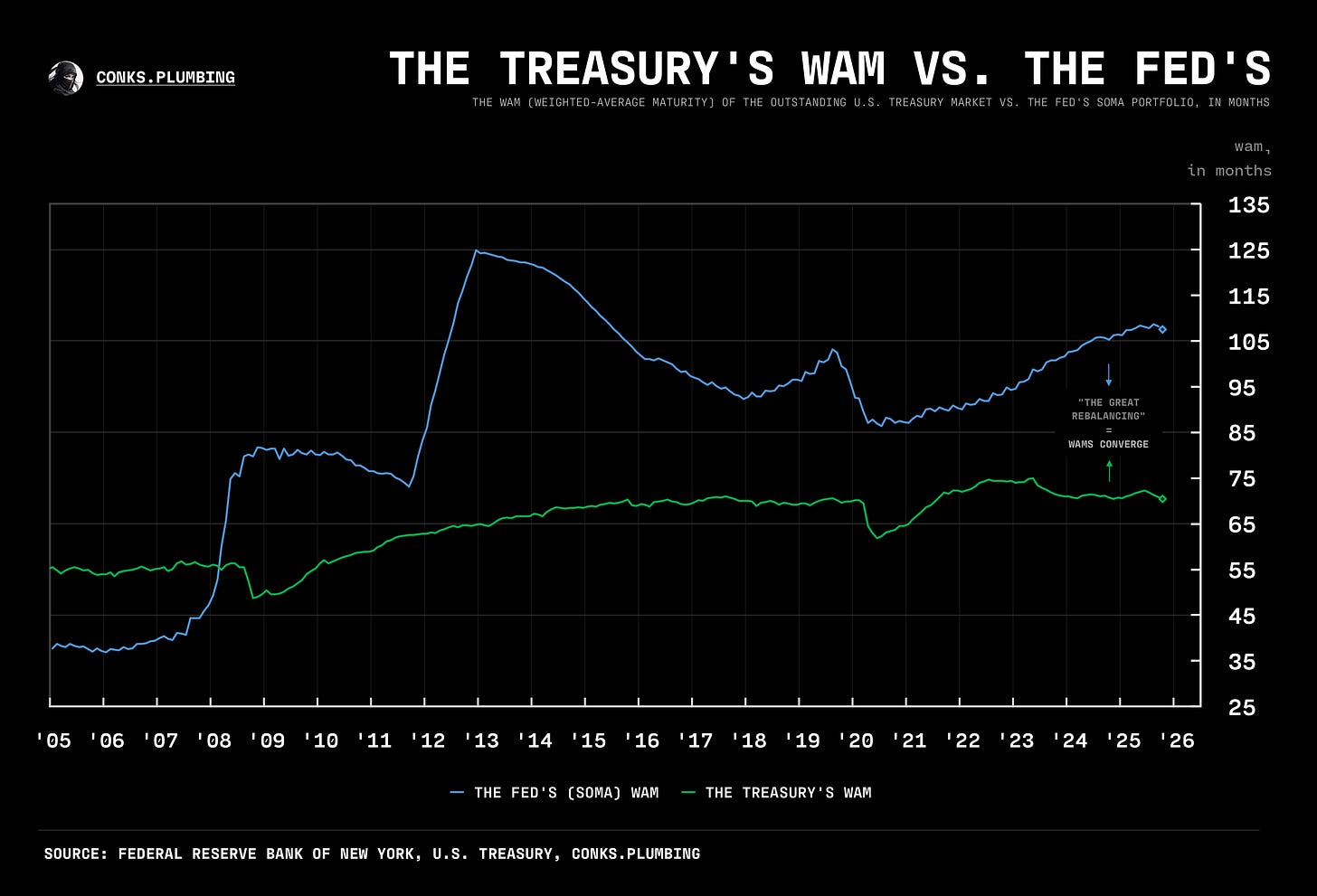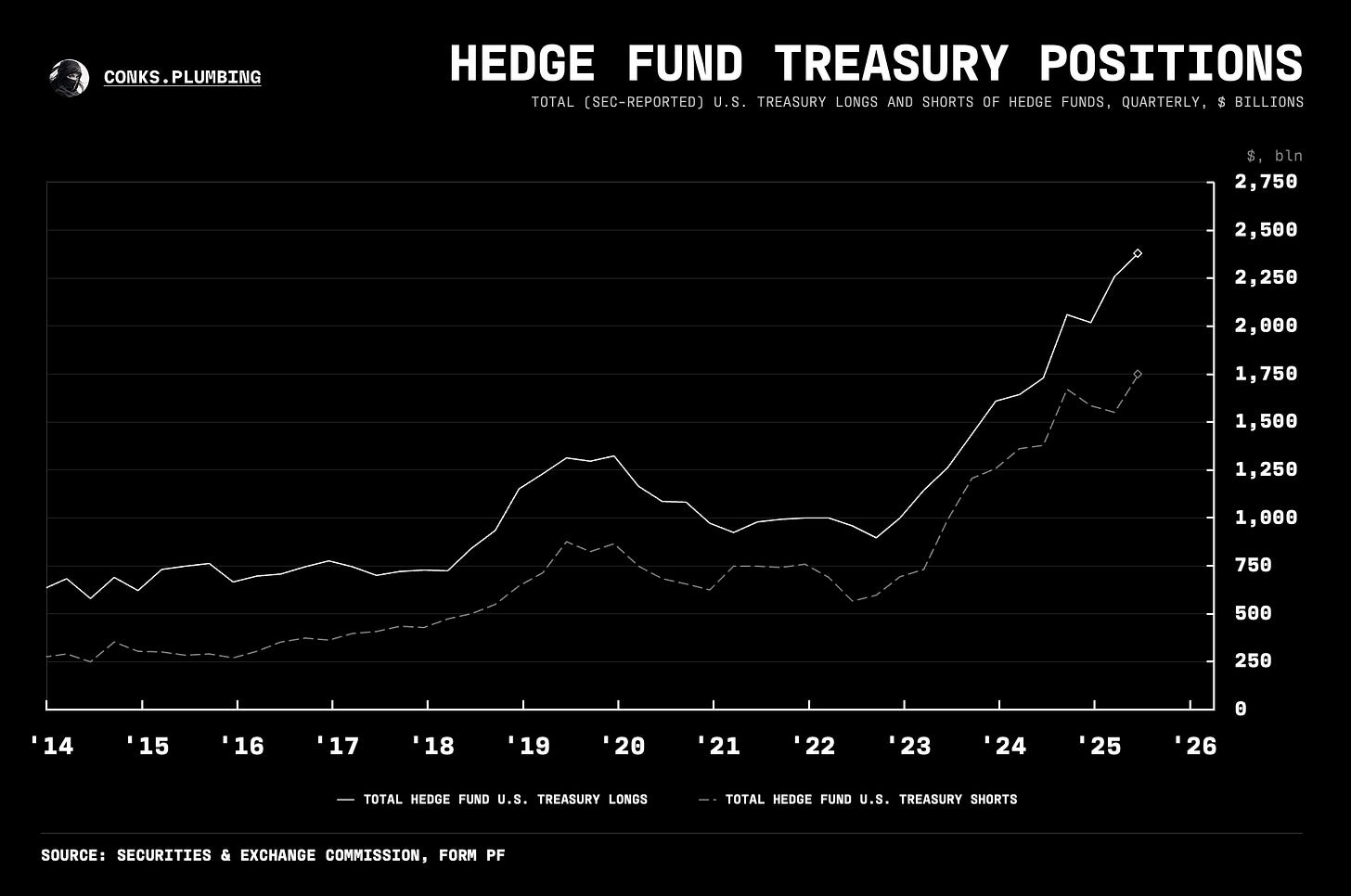Plumbing Notes: The Basis Trade Scare
the latest on the most systemically important bond market trade
Welcome to Plumbing Notes #2. Going forward, since our schedule is too unpredictable to pre-announce, each major upcoming work will have a progress bar to hint at what may come next. Major works include an infographic deck on the modern Eurodollar system [██▒▒%], a detailed look at the Fed’s Great Rebalancing [█▒▒▒%], and a new central bank target rate [███▒%]…
But first, a Plumbing Notes on the most systemically important trade in bond markets…
Money Market Commentary: The Basis Trade Scare
Regulators and commentators have, once again, started to talk about the basis trade — a shorthand for the cash-futures basis trade (illustrated by Conks above), the primary glue holding UST (U.S. Treasury) cash, futures, and repo markets together, fueling the most efficient sovereign bond market on the planet. Data on basis trade activity remains scarce, but it is likely to exceed $1 trillion in exposure. Subsequently, as hedge fund leverage reaches new heights, monetary leaders have grown nervous. So anxious, in fact, that many media and financial commentators have started to join in. The outcome has been a series of posts and articles that have overlooked the recent evolution in the most systemically important trade and instead focus on potential market doom. The cash-futures basis trade “scare”, however, remains overblown.
The mainstream depiction of basis trades portrays hedge funds (mostly relative hedge funds) going either “long (the) basis”, buying a cash bond via repo, selling (short) futures, and delivering the bond into the futures contract, or “short (the) basis” (taking the opposite trade). This, however, masks much of the intricacy. Beyond simply buying (selling) the cash bond and selling (longing) futures, the way the basis is calculated reveals a broader range of catalysts that traders aim to exploit through long or short basis positions.
Basis traders tend to measure the basis via the “net basis” by taking the bond that’s cheapest to deliver (CTD), subtracting carry (i.e. interest accrued on the bond minus repo costs to enter the trade), and deducting the adjusted futures price. Unlike social media experts, participants measure net basis moves in ticks, with one tick roughly equaling only 3bps of total exposure, as the trade is highly leveraged up to 60x via repos.This reveals that funding rates (the cost of financing the bond “leg” via repo), the perceived relative value between bonds and futures, and “optionality” gained via the ability to choose which bond to deliver — and when — into futures contracts, all determine the basis and thus potential profit (and loss).
Despite the basis trade being an RV trade, delivery options “embedded” in futures contracts have value and also change, turning the basis trade into a volatility play. Unlike social media experts who cite a rise in UST yields as a threat, volatility in yields is crucial for a long basis position to profit. In most cases, rising rates don’t knock out basis traders since their long and short positions offset each other. A significant move in yields results in the short futures position neutralizing the loss in cash bonds while volatility increases, aiding a long basis trade (e.g. because the delivery options grow in value, expanding the net basis). Basis traders must then monitor not only the direction and volatility of USTs but also changes in the yield curve, as bonds in the deliverable basket have different durations and yield movements. Recently, most traders have remained long the basis, so the worst outcome would be that yields barely move and the yield curve flattens. Upon delivery approaching, futures would eventually gain value relative to the cash bond, and the value of delivery options would “decay”.
As for basis trades being squeezed out by money market volatility, repo rate “spikes” of 15bps, even when repo rates rise significantly above the SRF, will not phase a basis trader, who can tolerate at least a 50bps move before running into trouble, and up to 200bp moves nearer to delivery dates. Some basis trades are also financed via term repos, where repo rates are fixed, unlike overnight (o/n) repos, thereby eliminating the risk of rising funding costs. What’s more, those using o/n funding are likely not willfully exposing themselves to higher risk but are instead allowing themselves to profit via even more trade expressions, only available via trading o/n repos as compared to term, since a move in repo rates affects the basis.
Instead, the worst scenario would be UST cash bond and futures prices detaching just as basis traders grow most sensitive to repo shocks (following quarter-ends after the latest contract rolls), a scenario most likely to knock traders out of positions. Trump’s tariff cascade just happened to materialize shortly after a futures roll, creating a genuine threat of a basis trade unwind. But Trump soon capitulated following bond market jitters, presumably after some basis positions benefited from volatility and a yield curve steepener. These trades likely experienced minimal turmoil because overall market structure had been supportive of leverage, allowing the RV community to continue achieving 60x leverage and generating >5% returns with comfort.
A peak in basis volumes, however, may have arrived for now. Yields have fallen, the UST curve is no longer steepening, and bond volatility and frictions remain suppressed, as will likely be the case in 2026. These shifts, along with the Fed ending QT, should create fewer opportunities. Still, demand from asset managers for futures will continue to drive dislocations.
The cash-futures basis trade will thus remain the central boogeyman in UST markets. There have even been calls to replace hedge funds as the margin liquidity provider in the UST market, even without a solid replacement. Banks can’t fill the gap left by RV funds after Basel III restricted their maximum allowable leverage, allowing hedge fund players to take market share. Foreign demand has been flatlining for over a decade, while money funds (MMFs) have been forced by regulators to invest further down the curve. These frictions have not only made hedge funds the major marginal buyers of USTs but made basis trades even more desirable to them.
Even so, the “romantic” version of bond-market doom will prevail, where basis traders get blown out during rising yields or mild repo volatility. First, losing money and defaulting are distinct scenarios. Second, in reality, it’s hard to even stop out an RV trader, let alone blow them up, unless a COVID-19-style event emerges. Monetary leaders will then be ready to provide liquidity via outright UST purchases or, if needed, at a penalty rate via a new “basis purchase” facility. The resulting moral hazard is already baked into pricing and traders’ behavior. Nonetheless, regulators still fear leverage because they know they will have to intervene via outright bond purchases. The decades-long push to reduce the need for intervention (by intervening beforehand!) will prove insufficient. The basis trade and hedge fund leverage that fuels it remains irreplaceable, binding UST markets together. The Fed will have to face and quell a genuine basis scare, whether they like it or not — but the damage should be minimal.
More Plumbing Notes
From the Conks feed (chat): updates on the November cash “flood” & more…
In today’s Pro: the modern players engaging in basis trades, potential “basis bailout” solutions, how the Fed’s SRF influences basis trader behavior, and more color…
Chartbook
Changelog: N/A
WIP: STIR monitor/Treasury monitor to accompany these updates






























Another banger. One thing I consider with this trade is regulators, et al need this trade to endure and be attractive. Funds running this trade are increasingly a marginal buyer (if not the marginal) buyer of treasuries. This trade has to endure to keep that in place.